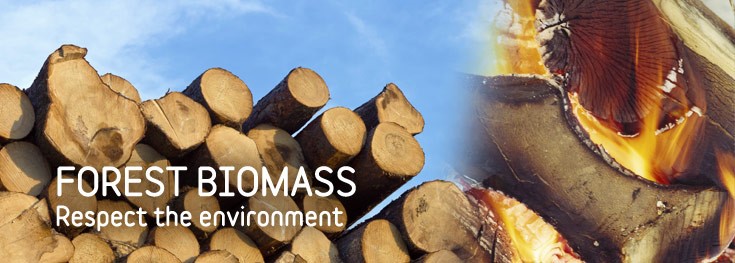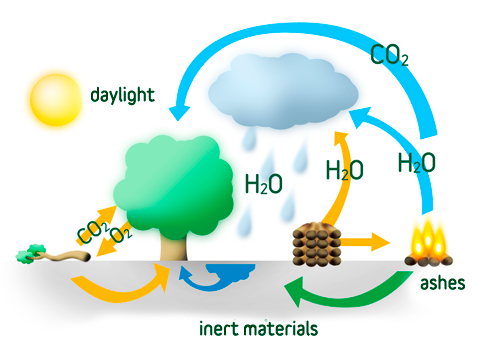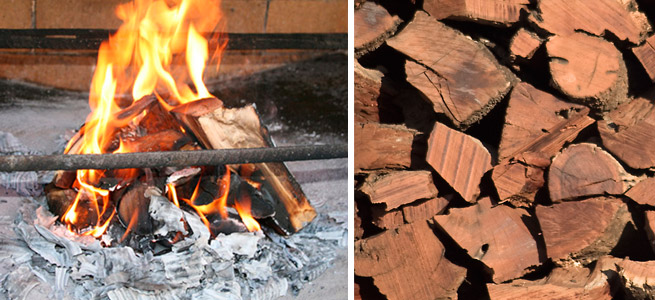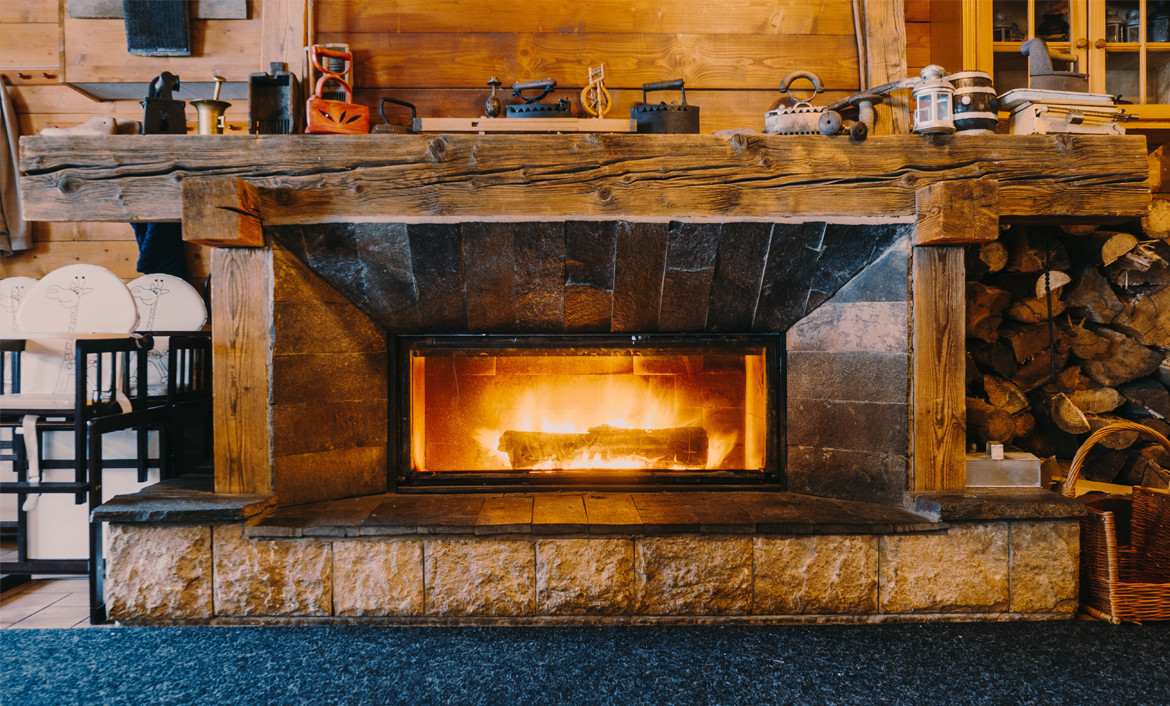
What is forest biomass?
Forest biomass consists of the energy products and energy obtained from the waste products from the pruning, cutting, clearance and conservation of forests (neither agricultural waste nor other ways of obtaining biomass). Because it is obtained from the waste products of nature itself, it is a renewable, environmentally friendly and clean resource.
Biomass is organic and inorganic matter formed in a biological or mechanical process, usually from the substances that constitute living beings or their remains and debris. Biomass contains energy that can be used in various ways (burning, conversion into other substances that will later be used as fuel or food, etc.).
The special features of the responsible and sustainable collection of this raw material also contribute to:
The maintenance and clearance of timber areas for reforestation.
The reduction of fire damage.
The recovery of waste
ADVANTAGES

Forest biomass versus fossil fuels
Forest biomass has several advantages over fossil fuels:
It is environmentally friendly because it has a neutral balance of CO2 emissions.
It causes a reduction in greenhouse gases through fossil fuel substitution.
Managed sustainably, it is an abundant and inexhaustible source of energy.
Its use reduces our energy dependence on fossil and exhaustible energy sources.
It comes from local or national sources or nearby countries.
It promotes greater fixing of the rural population by generating economic activity close to rural communities.
Prices are more competitive and stable than for fossil fuels.
Los precios son más competitivos y estables que los de las energías fósiles.
FOREST BIOMASS PRODUCTS
Choose the right fuel for heating your home
Here are the features that the main biomass fuels should have to ensure the highest quality:
Pellets
To identify good quality pellets you just have to check certain details:
They should be free of foreign bodies such as paper, metal or earth.
The pellet should be compact and not crumble too much during handling. If it has too much dust or sawdust, its combustion will produce too much ash and soot and soil the stove more quickly.
If the pellet is cracked, then it has moisture. This will reduce its heat output and increase the amount of smoke produced in combustion.
The color should be uniform. If the pellet has brightly colored spots this means it contains waste from other materials (plastic, paper, etc.) mixed with the sawdust itself.
The pellets should be high density, higher than water. Check the quality of the pieces by dipping a small number in a container with water. Good quality pellets will sink. But beware, if after 5 minutes in the water the pellets do not break up, it is more than likely that they contain glues or other binders, causing more smoke on combustion.
Briquettes
The best quality briquettes are made with natural biomass, i.e. natural compacted sawdust, and do not use any type of binder as the moisture and wood lignin itself work as natural glue.
If they are made of hardwood waste such as oak, their quality will be unbeatable. If, however, they are made of softwood, their durability will be less and they will turn out to be less economic.

Wood
Whatever wood you are going to use, remember that it must be really dry. Badly dried wood can contain up to 75% water, which means it gives much less heat because much of the energy is used to evaporate the water it contains. In addition, wet wood gives off a lot of smoke containing many fine particles of air pollutants. By contrast, when the wood is dry it only releases carbon dioxide, which is recaptured in photosynthesis.
It is important to remember that the drier the logs, the less they weigh, which also affects the price.
Remember never to use wood that has undergone any chemical treatment, such as parquets, chipboard or railway sleepers; its combustion can give off toxic gases and is also very dirty.
Chips
As with other materials, chips should be well dried. Adequate drying will result in good quality chips, i.e. with low moisture content, high calorific value, and low ash content. Chips are mainly used as kindling for the fire in which longer lasting firewood logs will later be burned. It is therefore vital that the fire they produce is good and strong until the other firewood is well lit.
If you have any questions on the use of these fuels in your fireplace, stove, boiler, barbecue, oven, etc., always remember to ask your technical service, who will inform you about the most suitable type of fuel.
SAVING ENERGY
Energy saving tips
Saving energy not only allows you to spend less; the environment will also benefit. Here are a few tips you can put into practice every day. Your pocket will thank you, the environment too.
SAVING ENERGY IN THE USE OF HEATING
Up to 60% of the energy consumed at home is for heating. It is very important to optimize the use of heating for the economic cost to be reasonable and impact on the environment as low as possible.
Here are a few tips to help you save energy by using your heat in an efficient and responsible way:
1. During the winter, the ideal temperature at home is between 19º C and 20° C during the day and between 15° C and 17° C overnight. There's no need to go in short sleeves, its winter! The idea is for the temperature to be pleasant and allow you to be at home in comfort. Just one degree above the recommended temperature will cause a substantial increase in consumption ... and in your bill.
2. Adjustable and programmable thermostats are an optimal solution to achieve energy efficiency. The heating will turn off or the temperature drop when the house is empty, thereby avoiding unnecessary consumption. Similarly they can be programmed to lower the temperature in rooms that are used less, such as bedrooms.
3. In the case of empty rooms or those in which hardly anything is ever done, it is advisable to turn down the heating or even turn it off.
4. 30% of the heating needs of our house are due to heat loss through windows. Ensure that they are well closed and that they fit properly. With suitable thermal insulation heating savings can be from 20% to 40%.
5. When it comes to ventilating the house, just keep the windows open for 10 to 15 minutes a day. You should also ventilate all rooms at the same time so that the loss of heat accumulated in the home is less.
6. Check your heating system regularly. Do not wait until there is a failure to call the technician; a repair may involve high costs or even loss of equipment.
7. If your system works with radiators, bleed them regularly to prevent the air that is trapped in the circuit impeding the passage of hot water and reducing the performance of the radiator.
8. Do not cover radiators or impede the passage of heat; they will have to make greater efforts to heat the area and energy expenditure will increase. Do not dry clothes on them and keep them away from sofas or other furniture; their performance will be better.

SAVING ENERGY AT HOME
Reducing energy consumption at home increases savings and helps protect the environment.
Here are some useful tips to save energy every day in your home:
1. Replace your old incandescent bulbs, if you have not already done so, with energy saving light bulbs.
2. Make the most of sunlight before turning on the lights. Turn off lights in rooms that are empty.
3. Turn off and unplug any device or appliance you are not using. If access to the plug is difficult (if it is behind a cupboard, etc.), install a power strip with an on/off switch. Appliances in standby mode still consume energy, accounting in most households for between 5% and 10% of the total energy consumed.
4. The iron is one of the most energy-intensive appliances in the home. You should take advantage of the heat by ironing as many clothes as possible at the same time, leaving as much time as possible between each ironing session (once a week would be adequate).
5. Keep your refrigerator door closed and open it as little as possible. Remember that every time you open it, it loses 20% of energy. Avoid placing the refrigerator or freezer near a heat source, which causes it to malfunction; consumption can be 3 times higher than normal.
6. Use the washing machine at full capacity. Whenever possible, use short cycles and cold water. Consumption may be reduced by as much as half.
7. Whenever possible, avoid using the dryer.
8. Use the dishwasher fully loaded.
